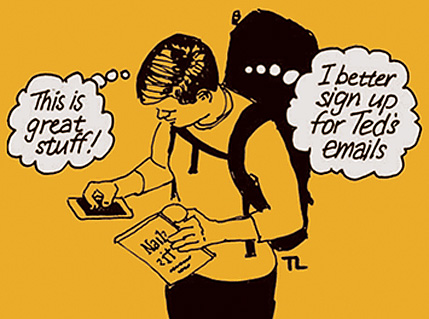How to Present Your Freelance Rates to Clients

I recently got a panicked email from a coaching client of mine:
Hi Ted,
I’ve nearly hooked this new client and I’m excited to start painting her grandkids but she just sent an email requesting a phone call and it’s freaking me out. What could she want? She says she thinks the “price point” is too high. I just want to paint! I hate negotiating but I desperately need the work. What should I say?
Binta
Binta, like many of the independent workers I coach, is a creative professional who hates talking money. While she started her career as a graphic artist at an agency, Binta now works for herself as a portrait painter. Like a lot of self-employed people, she went out on her own because she loves the work she does and wanted to escape the bureaucracy and distractions that came with working on a team.
But that meant having to handle awkward pricing conversations all on her own. And the first obstacle in Binta’s way was that she was thinking (as her prospective client was) about the sticker price, not value.
Shifting the Conversation from Fees to Value
Like many people who go freelance, Binta hadn’t accounted for what working in an organization provides — namely, entire departments filled with people whose sole job it is to take care of sales and marketing, so creatives like her wouldn’t have to. Not to mention a name brand that can lend market credibility to her personal talents. So the key to taking care of herself financially now meant making up for those losses.
For any of us who are lucky enough to do work we love (or even like), we just want to do that work. We want the value of it to be apparent and automatically agreed upon. But it’s never that simple. You sometimes have to be willing to be uncomfortable in order to get what you want — indeed, you need to if you’re going to survive as an independent worker.
Establishing your professionalism without a legitimizing organization can be difficult, and one of the most important things you can do in that regard is to set your pricing and stick with it. If you waffle, you’ll get taken advantage of. But before you can start talking price to prospects and clients, you need to establish value first.
When you work for a company, its own name-brand is a shorthand for value. Without it, you need to talk about what you do and the value it produces all by yourself. And you need to do it in a way that leaves your prospects in disbelief at the bargain they’re getting once you finally do tell them the cost. It sounds like a tall order, but it can be done. Here’s how.
Analyze What You Know
One of the first things I do to reduce my anxiety during moments like these is to think analytically about what my prospective client says and does. Did the prospect contact you in the first place? That alone suggests they’re already half committed to working with you. If they’re asking about price, what words did they use? Do they sound business-like? Insightful? Uncomfortable?
Binta’s client-to-be was a grandmother with plenty of money to spend. I suspected right away that “price point” was someone else’s phrase — she likely wasn’t a hard-driving negotiator who spent her days closing business deals. Chances are she felt just as uncomfortable hashing out the terms as Binta did. Look for subtle signs of your prospect’s own emotional state heading into a negotiation: What do you know, and what can you make educated guesses about based on what you know?
Get the Prospect Emotionally Engaged
The creative professionals I’ve worked with all my life have a powerful ability to make emotional connections. Binta’s commission was to paint somebody’s grandchildren, so she needed to ask her prospect about them and their relationship. I suggested things like:
- What’s your favorite thing about each child?
- Have you been thinking about portraits for long?
- What inspired you to have their portraits painted?
That’s not much of a stretch for an emotionally connected artist. But I’ve known excellent insurance salespeople who could make meaningful, deeply felt connections around the care their clients had for their families. But if you just stick to the cold, hard business terms, you’re bound to fail at elevating the discussion from price to value.
Describe the Care and Details that Go into Your Work
It’s important to remember — and to remind the prospect — that price isn’t just for product, it’s for process. Tell prospects what they’re paying for as you talk about the work you do to get to the end product they want. Auto mechanics usually bill for labor as a separate line item; you might not want to do exactly the same, but you still need to break down your work for your client in similar terms.
With this job, Binta would be committing to a lengthy, thorough process. She starts with a fun photo session, then works with the client to choose the right image, tinkering with that until it’s just right and printing it out full size, all before starting painting. A commission for Binta is much more than the end result.
So here’s what I eventually told her:
Once you’ve helped the prospect remember just how excited she is about this project and you’ve covered your process, summarize by saying the number of portraits, how long it will all take, and the total cost.
Then just say, “How does that sound?” and not another word. If she asks about or changes something in the scope of work, schedule, or price, revise your description and discuss again until you reach an agreement.
To make a long story short, they did.
This article originally appeared on Fast Company.

To the Point
A short list of creative people who are nailing it right now.
Brooke Bass — photographer, writer, chef and force behind Chocolate + Marrow is six months into her adventures chronicling life (and cuisine) aboard a 40-foot cruising boat.
Leonardo Da Vinci — Well, in this case, the good folks at The British Library, who’ve digitized Dav Vinci’s Notebook and made it available — FREE — online.
Christopher Paul Jordan — Tacoma artist named recipient of the $25,000 Neddy Award from Cornish College for his body of work addressing the experiences of people of color.
Need more inspiration?
A reminder: 7 science-backed reasons you should make art, even if you’re bad at it
Read NAIL: The Magazine for Creatives in Today’s World. Get your copy here.

